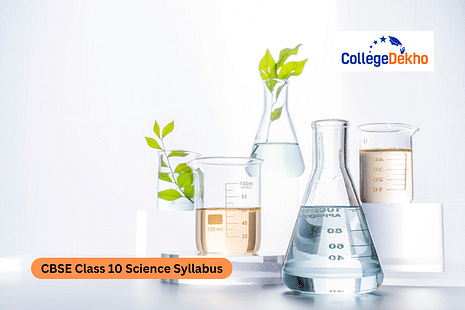CBSE Class 10 Science Syllabus 2026 has been released by the Central Board of Secondary Education on the official website @ cbseacademic.nic.in. The Science paper will be conducted for 80 marks.


Never Miss an Exam Update
CBSE Class 10 Science Syllabus 2026 has been released on the official website of CBSE Academics at cbseacademic.nic.in. The CBSE Class 10 Science Syllabus comprises 5 units, namely Chemical Substances-Nature and Behaviour, World of Living, Natural Phenomena, Effects of Current, and Natural Resources. 100 marks are allotted for the subject, out of which 80 marks are allotted to the theory paper, with 20 marks for the Internal Assessment. In addition to this, the CBSE Class 10 Syllabus also includes a list of Practicals to be performed. You must also check out the detailed CBSE Class 10 Science Exam Pattern 2026 .
You can also download the latest CBSE Class 10 Science Sample Paper 2026 for revision. Read more about the CBSE Class 10 Science Syllabus 2026 below:
CBSE Class 10 Science Syllabus 2026 PDF
You can now download the CBSE Class 10 Science Syllabus 2026 PDF below:
CBSE Class 10 Science Syllabus 2026: Structure
Check the unit-wise marks distribution tabulated below:
Units | Marks |
|---|---|
Unit 1: Chemical Substances-Nature and Behaviour | 25 |
Unit 2: World of Living | 25 |
Unit 3: Natural Phenomena | 12 |
Unit 4: Effects of Current | 13 |
Unit 5: Natural Resources | 05 |
Total | 80 |
Internal assessment | 20 |
Grand Total | 100 |
Download CBSE Class 10 Science Previous Year Question Paper
CBSE Class 10 Science Syllabus 2026
Refer to the detailed unit-wise CBSE Class 10 Science Syllabus 2026 below:Unit 1: Chemical Substances – Nature and Behaviour
Theme | Topics |
|---|---|
Chemical reactions | Chemical equation, Balanced chemical equation, implications of a balanced chemical equation, types of chemical reactions: combination, decomposition, displacement, double displacement, precipitation, endothermic exothermic reactions, oxidation and reduction |
Acids, bases and salts | Their definitions in terms of furnishing of H+ and OH– ions, General properties, examples and uses, neutralization, concept of pH scale (Definition relating to logarithm not required), importance of pH in everyday life; preparation and uses of Sodium Hydroxide,Bleaching powder, Baking soda, Washing soda and Plaster of Paris. |
Metals and nonmetals | Properties of metals and non-metals; Reactivity series; Formation and properties of ionic compounds; Basic metallurgical processes; Corrosion and its prevention |
Carbon compounds: | Covalent bonding in carbon compounds. Versatile nature of carbon. Homologous series. Nomenclature of carbon compounds containing functional groups (halogens, alcohol, ketones, aldehydes, alkanes and alkynes), difference between saturated hydro carbons and unsaturated hydrocarbons. Chemical properties of carbon compounds (combustion, oxidation, addition and substitution reaction). Ethanol and Ethanoic acid (only properties and uses), soaps and detergents. |
Unit II: World of Living
Themes | Topics |
|---|---|
Life processes | ‘Living Being’. Basic concept of nutrition, respiration, transport and excretion in plants and animals |
Control and co-ordination in animals | Tropic movements in plants; Introduction of plant hormones; Control and co-ordination in animals: Nervous system; Voluntary, involuntary and reflex action; Chemical co-ordination: animal hormones. |
Reproduction | Reproduction in animals and plants (asexual and sexual) reproductive health - need and methods of family planning. Safe sex vs HIV/AIDS. Child bearing and women’s health. |
Heredity and Evolution | Heredity; Mendel’s contribution- Laws for inheritance of traits: Sex determination: brief introduction: (topics excluded - evolution; evolution and classification and evolution should not be equated with progress). |
Unit III: Natural Phenomena
Themes | Topics |
|---|---|
Reflection of light by curved surfaces | Reflection of light by curved surfaces; Images formed by spherical mirrors, centre of curvature, principal axis, principal focus, focal length, mirror formula |
Refraction of light by spherical lens | Refraction; Laws of refraction, refractive index. Refraction of light by spherical lens; Image formed by spherical lenses; Lens formula |
Human Eye | Functioning of a lens in human eye, defects of vision and their corrections, applications of spherical mirrors and lenses |
Refraction of light through a prism | Functioning of a lens in human eye, defects of vision and their corrections, applications of spherical mirrors and lenses. Refraction of light through a prism, dispersion of light, scattering of light |
Unit IV: Effects of Current
Themes | Topics |
|---|---|
Effects of Current | Electric current, potential difference and electric current. Ohm’s law; Resistance, Resistivity, Factors on which the resistance of a conductor depends. Series combination of resistors, parallel combination of resistors and its applications in daily life. Heating effect of electric current and its applications in daily life. Electric power, Interrelation between P, V, I and R. |
Magnetic effects of current | Magnetic field, field lines, field due to a current carryingconductor, field due to current carrying coil or solenoid; Force on current carrying conductor,Fleming’s Left Hand Rule, Direct current. Alternating current: frequency of AC. Advantage of AC over DC. Domestic electric circuits. |
Unit V: Natural Resources
Our environment: Eco-system, Environmental problems, Ozone depletion, waste production, and their solutions. Biodegradable and non-biodegradable substances.
CBSE Class 10 Science Practical Syllabus 2026
Check the list of exoperiments included in the CBSE Class 10 Science Practical Syllabus 2026 below:
1. A. Finding the pH of the following samples by using pH paper/universal indicator: Unit-I
(i) Dilute Hydrochloric Acid
(ii) Dilute NaOH solution
(iii) Dilute Ethanoic Acid solution
(iv) Lemon juice
(v) Water
(vi) Dilute Hydrogen Carbonate solution
B. Studying the properties of acids and bases (HCl & NaOH) on the basis of their reaction with:
Litmus solution (Blue/Red)
Zinc metal
Solid sodium carbonate
2. Performing and observing the following reactions and classifying them into:
A. Combination reaction
B. Decomposition reaction
C. Displacement reaction
D. Double displacement reaction
i) Action of water on quicklime
ii) Action of heat on ferrous sulfate crystals
iii) Iron nails kept in copper sulfate solution
iv) Reaction between sodium sulfate and barium chloride solutions
3. A. Observing the action of Zn, Fe, Cu, and Al metals on the following salt solutions:
ZnSO 4 (aq)
FeSO 4 (aq)
CuSO 4 (aq)
Al 2 (SO 4 ) 3 (aq)
B. Arranging Zn, Fe, Cu, and Al (metals) in the decreasing order of reactivity based on the above result.
4. Studying the dependence of potential difference (V) across a resistor on the current (I) passing through it and determining its resistance. Also plotting a graph between V and I.
5. Determination of the focal length of (i) Concave mirror and (ii) Convex lens by obtaining the image of a distant object.
6. Preparing a temporary mount of a leaf peel to show stomata.
7. Experimentally show that carbon dioxide is given out during respiration.
8. Study of the following properties of acetic acid (ethanoic acid)
i) Odour
ii) solubility in water
iii) effect on litmus
iv) reaction with Sodium Hydrogen Carbonate
9. Study of the comparative cleaning capacity of a sample of soap in soft and hard water.
10. Determination of the focal length of:
i) Concave mirror
ii) Convex lens
by obtaining the image of a distant object.
11. Tracing the path of a ray of light passing through a rectangular glass slab for different angles of incidence. Measure the angle of incidence, angle of refraction, and angle of emergence and interpret the result. Unit - III
12. Studying (a) binary fission in Amoeba, and (b) budding in yeast and Hydra with the help of prepared slides. Unit-II
13. Tracing the path of the rays of light through a glass prism. Unit-III
14. Identification of the different parts of an embryo of a dicot seed (Peas, gram, or red kidney bean).
Also Read: CBSE Class 10 Mathematics Syllabus 2026
CBSE Class 10 Science Deleted Syllabus 2026
You can check the table below for the CBSE Class 10 Science Deleted Syllabus 2026 :
Chapter Name | Page No. | Dropped Topics/Chapter |
|---|---|---|
Chapter 5: Periodic Classification of Elements | 79–92 | Full chapter |
Chapter: 9 Heredity and Evolution (Chapter name replaced with: Heredity) | 147-158 | Box item: Charles Robert Darwin Box item: Origin of life on earth Box item: How do fossils form layer by layer Box item: Molecular phylogeny 9.3 Evolution 9.3.1 An Illustration 9.3.2 Acquired and Inherited Traits 9.4 Speciation 9.5 Evolution and Classification 9.5.1 Tracing Evolutionary Relationships 9.5.2 Fossils 9.5.3 Evolution by Stages 9.6 Evolution Should Not Be Equated With ‘Progress’ 9.6.1 Human Evolution |
Chapter: 11 The Human Eye and the Colourful World | 188, 189, 196 and 197 | Two box items: • Damage to or malfunction of any part of the visual system... • Why do we have two eyes for vision and not just one? 11.6.3 Colour of the Sun at Sunrise and Sunset |
Chapter: 12 Electricity | 201 | Box item: ‘Flow’ of charges inside a wire |
Chapter: 13 Magnetic Effects of Electric Current | 232–237 | Box item: Michael Faraday 3.4 Electric Motor 3.5 Electromagnetic Induction 3.6 Electric Generator |
Chapter: 14 Sources of Energy | 242–255 | Full chapter |
Chapter: 16 Sustainable Management of Natural Resources | 266–280 | Full chapter |
Refer to the syllabus provided above to prepare for the papers efficiently. Make sure to keep an eye out on the official website to catch all the latest updates regarding the exams.
Are you feeling lost and unsure about what career path to take after completing 12th standard?
Say goodbye to confusion and hello to a bright future!

FAQs
Students should start the CBSE Class 10 Science exam preparation from the first day. Regular practice will help students to perform better and score high marks.
No, Physics, Chemistry, and Biology are not separated in CBSE Class 10 Science Syllabus 2026. However, there are units that are covered in the syllabus that deals with these subjects separately.
There are five units presented in the CBSE Class 10 Science Syllabus 2026. All these units deal with the different chapters and topics so the students must prepare accordingly.
CBSE Class 10 Science Syllabus 2026 is prescribed for 100 marks. Theory paper will be for 80 marks and 20 marks will be allotted for the Practical Examination for which the syllabus is included in the official PDF.
To complete the CBSE Class 10 Science Syllabus 2026, students should focus on NCERT textbooks and then move on to the side books as prescribed by their teachers or their mentors.
CBSE Class 10 Science Syllabus 2026 is available on the official website of CBSE Academics. Students can download the syllabus by clicking on the curriculum option present on the menu bar.
Was this article helpful?
























